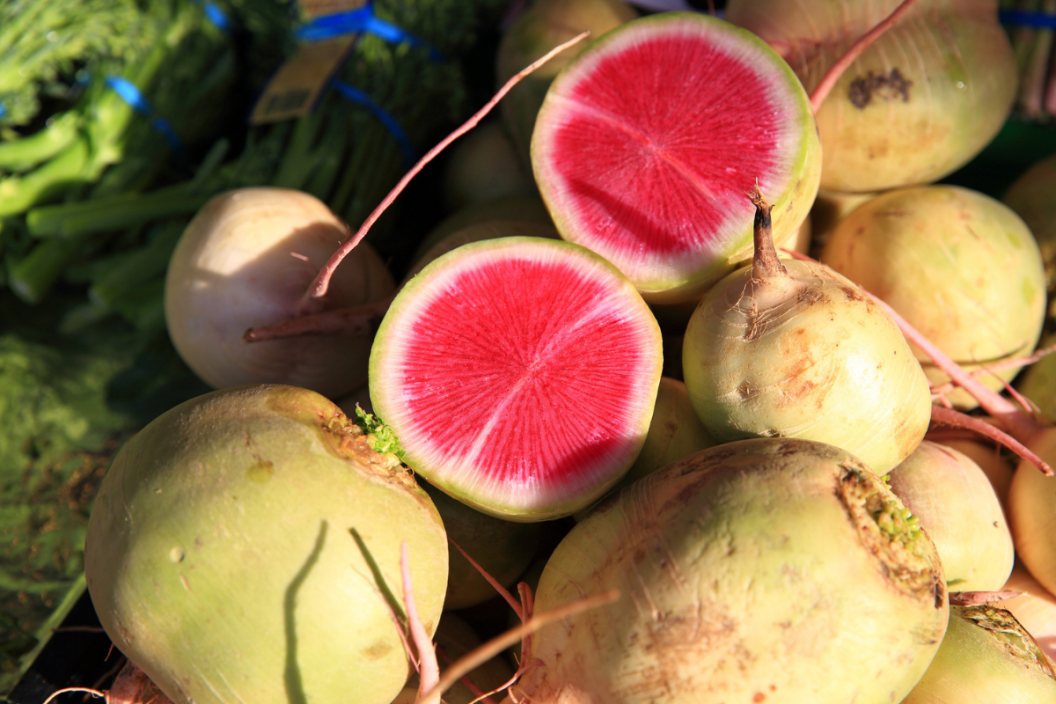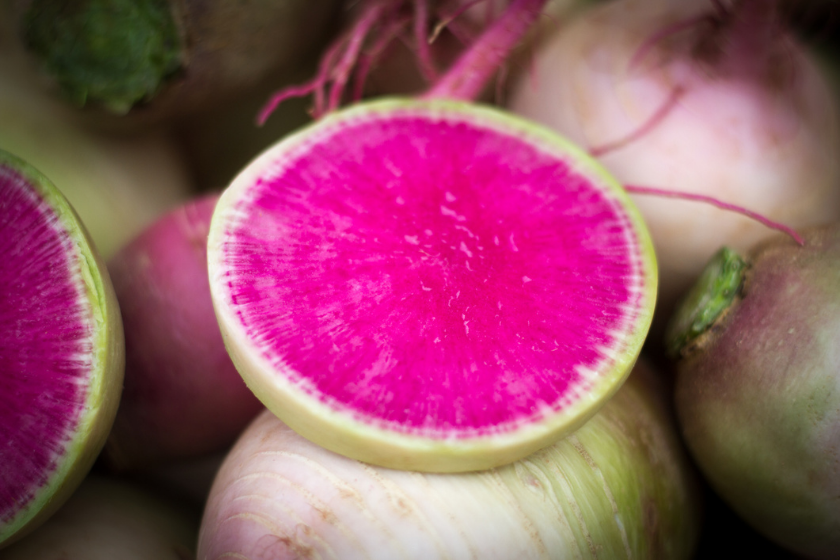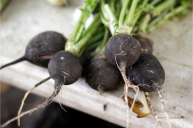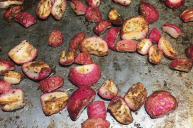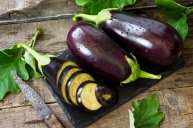Equal parts earthy and fresh, with a subtly bitter or even astringent note, radishes add complexities and bountiful textures to salads, cheeseboards, and veggie platters. They transform and mellow when cooked, and their greens offer a flavor that is not unlike spinach, kale, or other, more popular dark greens. Radishes also range in color, shape, consistency, and flavor. A daikon or a watermelon radish look and taste wildly different than a breakfast radish, and raw radishes can also be taken to the next level with nothing other than some salt and butter. However, radishes still seem to fly somewhat under the radar when contrasted with other forms of vegetables and produce. For those unacquainted with a radish's myriad wonders, here's a quick primer on the types of radishes and more.
A breadth of flavors and colors, radishes boast a peppery, sharp bite that is clean, fresh, and slightly earthy. They add a fascinating dynamic— in both texture and flavor— to any dish they're added to. They're technically a root vegetable. Because they're so often enjoyed raw, their nutritional benefits are typically more paramount than other produce which may be cooked prior to consumption. They have vitamins A, C, B6, E, and K, as well as minerals like potassium, phosphorus, magnesium, copper, calcium, iron, and manganese. While radishes contain a bounty of minerals, vitamins, and nutrients, they're often not consumed in a sufficient quality in order to actually be deemed a superfood.
Hailing from the Brassicaceae family— its siblings are mustard and cabbage, as well as cauliflower, kale, and broccoli— radishes are reliable for their sharp flavor and bright color. So what types of radishes are there?
Types of Radishes
Watermelon Radishes
Belied by their appearance, watermelon radishes are visually arresting once cut open. Dull, off-green skin gives way to bright, stunningly beautiful pink flesh that is almost hot pink in color. Often thinly sliced on a mandoline before being served in a salad, this bright radish provides texture, crunch, and gives beautiful, vivid color to any dish, along with the familiar, punchy radish flavor.
French Breakfast or Cherry Belle
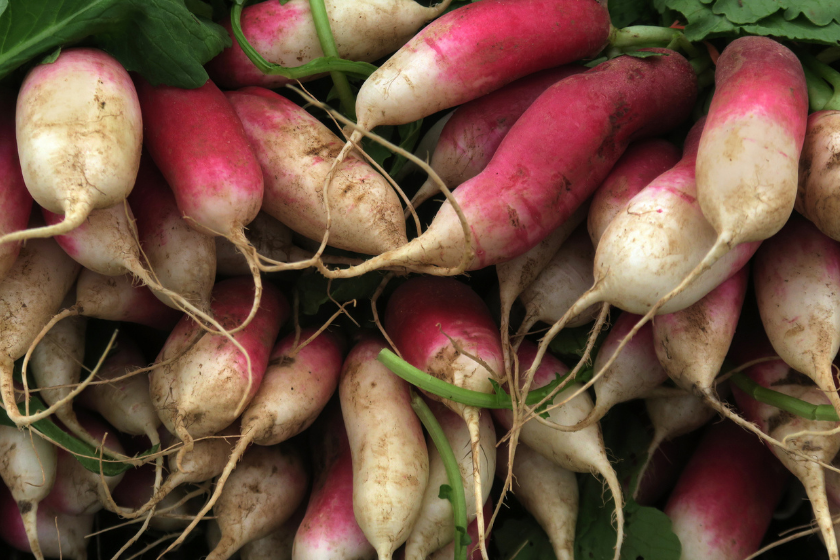
The typical radish you're likely to come across in a supermarket is actually called a Cherry Belle, while a breakfast radish—which some mistakenly conflate with cherry belles— are slightly smaller with a more oval-esque shape. French breakfast radishes are smaller orbs that tend to be oblong, and they're milder. Both are characterized by a fresh crispness, a sharp bite, and a textural crunch. The greens can also be used in pestos and sauces or even sauteed like spinach.
When working with these radishes, there's generally no need to peel them. Some are spicy, some are buttery— you never know what you might wind up with! This is one of the many perks of being a radish superfan.
Daikon
Daikon, on the other hand, looks entirely different, is much longer and larger, and can be a bit sharper in flavor than the smaller radish varieties.
Daikon is used in many Asian and Middle Eastern recipes and is oftentimes pickled or in otherwise fermented dishes. It's not often enjoyed raw and is sometimes used in kimchi. Daikon radishes can actually grow to be a foot in size! They're often cylindrical and white or off-white.
Black radish is another variety, which has a beige or gray interior. Other types are Malaga, rainbow, white icicle, and white hailstone, but they're much less common.
How To Use Radishes
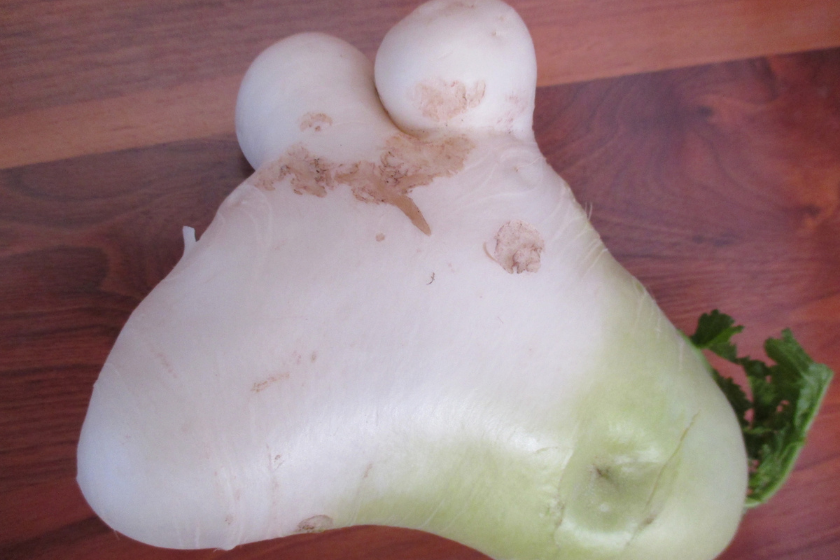
Radishes are best friends with mandolines. Of course, you can also practice your knife skills by slicing them super thinly by hand, but be careful! The smaller the radish, the trickier it can be to get a good handle on the vegetable in order to stabilize it when cutting. Make sure you're working with a properly sharpened knife, that you have a strong grip on the blade and handle, and that your fingers are tucked under. Another tip could be to slice a thin round off of one side of the radish so that it can lie flat and be sturdy as you begin to slice through. Lastly, take your time! There's no need to rush when slicing such a small, potentially precarious piece of produce.
What To Do With Radishes
Here are a few ideas for what to do with the many types of radishes out there:
- Add to a crudité platter
- Roast with olive oil, garlic, and seasonings
- Enjoy on a buttered baguette
- Thinly shred into a slaw of sorts
- Thinly cut and toss with a sharp vinaigrette and creamy cheese, or lemon and salt
- Use in a piquant salsa
- Puree into dips, soups, or add to mashed potatoes to spruce them up
- Sauteed in brown butter and flaky salt
- Chopped and tossed into warm grain salads with lots of lemon and fresh herbs
- Thinly slice on a mandoline and make chips
- Make sauteed radish greens with harissa and a fried egg
- Puree a radish green pesto with pistachios and Parmigiano Reggiano cheese
- Sauté radish greens with onions and pancetta
- Make radish kimchi
What are you making first?
READ: Black Radishes Are the Spicy Cousin of the Radishes You Know and Love
